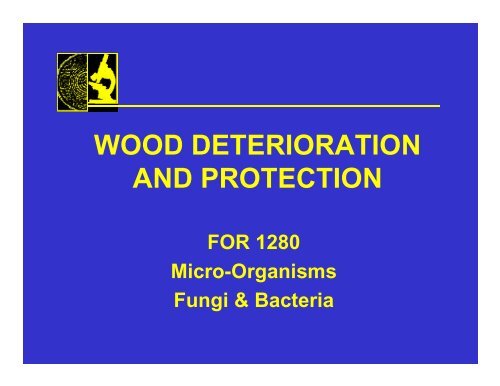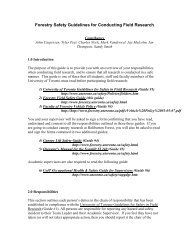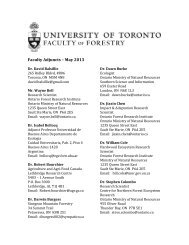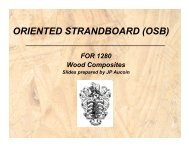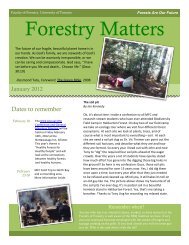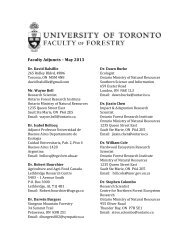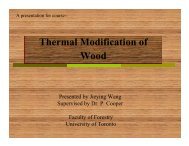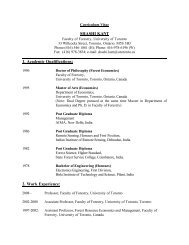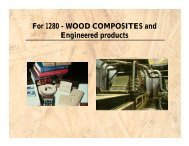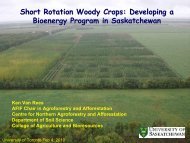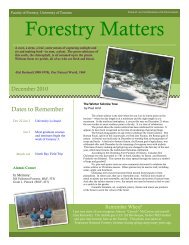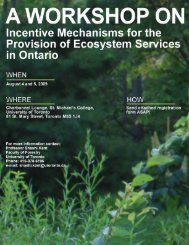WOOD DETERIORATION AND PROTECTION
WOOD DETERIORATION AND PROTECTION
WOOD DETERIORATION AND PROTECTION
Create successful ePaper yourself
Turn your PDF publications into a flip-book with our unique Google optimized e-Paper software.
<strong>WOOD</strong> <strong>DETERIORATION</strong><br />
<strong>AND</strong> <strong>PROTECTION</strong><br />
FOR 1280<br />
Micro-Organisms<br />
Fungi & Bacteria
Agents of Wood<br />
Deterioration<br />
BIOLOGICAL<br />
PHYSICAL<br />
Marine borers<br />
Bacteria<br />
Fungi<br />
Insects<br />
Fire<br />
Weathering<br />
Corrosion<br />
Splitting
MICRO-ORGANISMS<br />
• Bacteria<br />
• Mould fungi<br />
• Sapstain fungi<br />
• Soft rot fungi<br />
• True wood rotters (white and<br />
brown rot)<br />
ALL NEED FOOD,<br />
MOISTURE, OXYGEN <strong>AND</strong><br />
SUITABLE TEMPERATURE
• Filamentous cells<br />
(hyphae) adapted to<br />
penetrate, externally<br />
digest (by<br />
enzymes), absorb<br />
and metabolize<br />
organic material<br />
FUNGI
• Reproduce primarily by<br />
spores – 1 to several cells<br />
formed from hyphae in<br />
massive quantities<br />
• Disseminated by wind,<br />
rain, insects<br />
• Short life cycles and high<br />
variability allows rapid<br />
adaptation (resistance) to<br />
adverse effects such as<br />
fungicides<br />
FUNGI
• Based on types and<br />
features of spore bearing<br />
structures<br />
• Ascomycetes – some<br />
sapstain and soft rot<br />
fungi<br />
• Deuteromycetes –<br />
moulds and some<br />
staining and soft rot fungi<br />
• Basidiomycetes – “true<br />
wood rotters”<br />
CLASSIFICATION OF<br />
FUNGI
• Derive energy from low<br />
MW organics such as<br />
sugars and starch<br />
• Needs relatively high<br />
MC (20% +) and<br />
preferably some free<br />
water (condensation)<br />
• May penetrate wood<br />
with colorless hyphae,<br />
but mainly evident on<br />
surface<br />
• Heavy spore<br />
development on surface<br />
(green, black, blue, red<br />
yellow etc.<br />
Mould
Mould<br />
• Degrades building<br />
materials by colour,<br />
smell, toxicity of<br />
spores and (rarely)<br />
metabolites<br />
• Controlled by<br />
removal of water<br />
source, use of<br />
mildewicides,<br />
bleach, HEPA<br />
filtration
STAIN - BLUE OR SAP<br />
STAIN<br />
• Coloured hyphae<br />
penetrate sapwood<br />
mainly in ray cells<br />
• Feed on sugars and<br />
starches in ray<br />
parenchyma but may<br />
move into adjacent<br />
tracheids<br />
• Some cellulase enzymes<br />
as can penetrate end<br />
walls of ray cells and<br />
tracheid walls
• Degrades wood by<br />
discoloration and<br />
loss of impact<br />
strength and<br />
ultimately other<br />
strength properties<br />
• Increases radial<br />
permeability<br />
STAIN - BLUE OR SAP<br />
STAIN
• Attack wood soon after<br />
felling. Spores spread<br />
by air, water and<br />
especially insects<br />
• Enhanced by damage<br />
to bark during<br />
harvesting<br />
• Controlled by<br />
immediate kiln drying or<br />
anti-sapstain treatment<br />
STAIN - BLUE OR SAP<br />
STAIN
BLUE OR SAP STAIN<br />
CONTROL<br />
Formerly sodium<br />
Pentachlorophenate<br />
Now: IPBC, borates, quats,<br />
MBT, TCMTB
TRUE <strong>WOOD</strong> ROTTING<br />
FUNGI
Mode of attack
Mode of attack
SOFT ROT FUNGI<br />
• Slow surface decay of<br />
wood in extreme<br />
conditions: Water soaked,<br />
below permafrost, high<br />
fertilizer soil etc.<br />
• Characterized by cavities<br />
in the S2 layer of the cell<br />
wall<br />
• An issue for CCA treated<br />
hardwoods, since it can<br />
attack untreated<br />
secondary cell wall
Brown Rot
Brown Rot
WHITE ROT
White Rot<br />
• Can degrade both<br />
polysaccharides and<br />
lignin filtration<br />
• Mainly hardwoods -<br />
Can access the<br />
hardwood lignins<br />
easier than<br />
softwood lignins
Rate of Deterioration
Effect of decay on wood<br />
strength<br />
Strength Property Weight loss from decay % Strength loss %<br />
Toughness 2 60<br />
6 80<br />
MOR 2 13-50<br />
6 61<br />
MOE 2 4-55<br />
6 66<br />
Compression perpendicular 2 18-24<br />
6 48<br />
Compression parallel 2 10<br />
6 25<br />
Tension parallel 2 23-40<br />
6 60<br />
Shear parallel 2 3<br />
6 12
WHERE TO LOOK FOR<br />
<strong>DETERIORATION</strong><br />
Most organisms<br />
need moisture<br />
• Wood in soil, concrete<br />
or water contact<br />
• Joints and other areas<br />
where water can trap<br />
• Areas prone to<br />
condensation, leaks,<br />
weather exposure
CLIMATE INDEX – CI<br />
Sum monthly from January<br />
To December :<br />
(T -35)(D – 3)<br />
30<br />
T is mean monthly<br />
temperature<br />
in ºF and D is average<br />
number of days per month<br />
with rain more than 0.25 mm<br />
DECAY HAZARD MAP
Sterilization<br />
Time/Temperatures<br />
66 °C 75 minutes<br />
77 °C 30 minutes<br />
82 °C 20 minutes<br />
93 °C 10 minutes<br />
100 °C 5 minutes
Soil contact
Ground contact
MOISTURE TRAPPING<br />
• Checks and splits<br />
• End grain absorbs<br />
moisture<br />
• Joints most<br />
susceptible<br />
• Trapping under<br />
paint films, flashing<br />
etc.
Water Trapping
Trapped moisture
Water trapping
End grain absorption
Trapped moisture
POOR INSTALLATION<br />
• Failure to use end<br />
cut preservative<br />
• Ends not bevelled
End cut
CONDENSATION<br />
• Wood or other<br />
component below<br />
dew point<br />
temperature<br />
• Vapour barriers<br />
especially<br />
susceptible
Weather exposure
Weather exposure
POOR IN-SERVICE<br />
MAINTENANCE
THE IMPORTANCE OF<br />
DETAILS<br />
• “Dream Log<br />
Home<br />
• Approximately<br />
15 years old<br />
• White Pine<br />
• Log ends cut<br />
for shingles
Decay Detection<br />
• Visual<br />
• Picking/probing<br />
• Moisture content<br />
• Boring/drilling<br />
• Physical<br />
properties<br />
• Sonic or radiation
Non-destructive testing<br />
Picking/probing<br />
• Decayed wood is<br />
brash. Failure is<br />
abrupt not splintered
Source: www.imlusa.com<br />
Resistograph
Source: www.imlusa.com<br />
Resistograph
Electronic hammer<br />
Source: www.imlusa.com
Moisture content
Non-destructive testing<br />
• Increment<br />
cores<br />
• Appearance<br />
• Physical condition<br />
• Species<br />
• Culturing<br />
• Preservative depth<br />
• Strength
Culture of samples
EVALUATION OF<br />
DURABILITY<br />
Hierarchy of tests of increasing time but<br />
increasing reliability:<br />
• Agar tests: very fast (< 8 weeks) but only indicative<br />
• Soil jar (AWPA E10) 12-16 weeks usually with<br />
leaching<br />
• Fungal cellar test (accelerated field test (1-5 years)<br />
• Above ground L-joint, lap joint, test fence etc (years)<br />
• In ground stake or post tests<br />
• Service records
Kolle Flask (EN standard)<br />
• Pure cultures<br />
• Sterile wood and<br />
agar<br />
• Nutrient agar<br />
(Malt, potato<br />
dextrose, etc.)<br />
• Mass loss after 8-<br />
16 weeks
Soil Block Test (AWPA<br />
E10)<br />
• Pure fungus cultures<br />
• Wood & soil initially<br />
sterile<br />
• Feeder strip<br />
• 12 or 16 weeks at<br />
optimal Texposure<br />
• Based on mass loss or<br />
occasionally on reduced<br />
compressive strength
Fungal Cellar<br />
• FAB (Facility for accelerated biodeterioration)<br />
• Plastic or concrete container (small boxes to<br />
large crypts)<br />
• Unsterile soil (sometimes “fortified”)<br />
• Optimized T and moisture conditions<br />
• Small stakes (unsterile)<br />
• Based on loss in strength<br />
• Results seen in a few months for untreated<br />
wood – Acceleration factor approx. 10
EVALUATION OF<br />
DURABILITY
Above ground durability<br />
L-Joints
Above ground<br />
Lap-Joints
EVALUATION OF DURABILITY<br />
– STAKE OR POST TESTS


